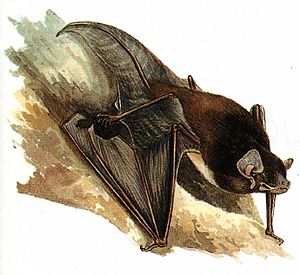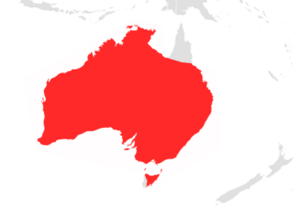Gould's wattled bat facts for kids
Quick facts for kids Gould's wattled bat |
|
|---|---|
 |
|
| Conservation status | |
| Scientific classification | |
| Genus: |
Chalinolobus
|
| Species: |
gouldii
|
 |
|
| Gould's wattled bat range | |
The Gould's wattled bat (Chalinolobus gouldii) is a type of Australian bat. It is known for the fleshy parts, called "wattles," at the corners of its mouth. This bat was named after an English naturalist, John Gould.
Contents
About Gould's Wattled Bat
Gould's wattled bat is the biggest bat in its group, Chalinolobus. These bats have special fleshy parts near their mouths.
On average, these bats are about 70 millimeters long (head and body). They usually weigh around 14 grams.
Where They Live
Gould's wattled bats live all over mainland Australia. You won't find them in the very north of Cape York Peninsula or the Nullarbor Plain. They also live in Tasmania, New Caledonia, and Norfolk Island.
These bats can live in many different places. In forests, they often live in trees. They might use tree stumps, hollow branches, or even old bird nests as homes. They can also live in cities, sometimes found in the ceilings or basements of buildings.
Some male bats might live alone. But often, these bats live in groups called colonies. A colony usually has about 30 bats. Some very large colonies can have up to 200 bats!
How They Behave
Gould's wattled bats are active all year in most places they live. However, in colder areas, they go into a deep sleep called hibernation. This usually happens during winter, from May to early September. Sometimes, they might even hibernate as late as December.
These bats are very common in special bat boxes. For example, at the Organ Pipes National Park in Melbourne, Australia, 97% of the bats found in these boxes were Gould's wattled bats. They are also often found in bat boxes in other parks nearby.
What They Eat
Gould's wattled bats are insectivorous, meaning they eat insects. In most places, their favorite food is moths. But in the wet, riverside forests of Tasmania, they eat mostly beetles.
They also eat other insects like cockroaches, flies, stoneflies, and different types of moths and caterpillars. Sometimes, they might accidentally eat grass seeds or small twig pieces.
Reproduction and Life Cycle
The way Gould's wattled bats reproduce can be different depending on where they live. This includes how long the mothers are pregnant.
In Victoria, female bats usually become pregnant in September and October. They feed their babies milk in November and December. The young bats are ready to fly on their own in December and January. In Western Australia, babies are born between late September and November. The exact time depends on how far north or south the bats live.
Female bats can store sperm for at least 33 days. This means they can get pregnant a long time after mating. Often, a mother bat will have twins. This is because pregnancy happens in both sides of her uterus.
See also
 In Spanish: Chalinolobus gouldii para niños
In Spanish: Chalinolobus gouldii para niños


